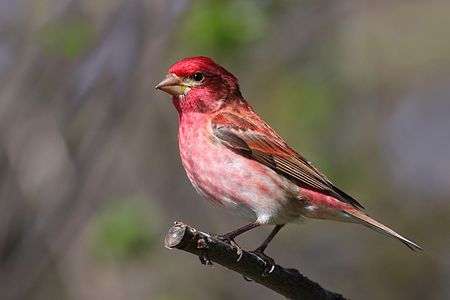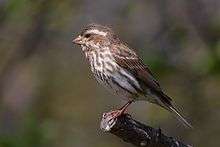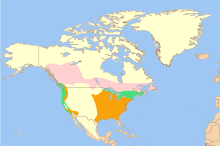Purple finch
| Purple finch | |
|---|---|
 | |
| Male | |
 | |
| Female | |
| Scientific classification | |
| Kingdom: | Animalia |
| Phylum: | Chordata |
| Class: | Aves |
| Order: | Passeriformes |
| Family: | Fringillidae |
| Genus: | Haemorhous |
| Species: | H. purpureus |
| Binomial name | |
| Haemorhous purpureus (Gmelin, 1789) | |
 | |
| Range of C. purpureus Breeding range Year-round range Wintering range | |
| Synonyms | |
|
Burrica purpurea | |
The purple finch (Haemorhous purpureus) is a bird in the finch family, Fringillidae.
Taxonomy
This species and the other "American rosefinches" were formerly included with the rosefinches of Eurasia in the genus Carpodacus; however, the three North American species are not closely related to the rosefinches of the Old World, and have thus been moved to the genus Haemorhous by most taxonomic authorities.
It is included in the finch family, Fringillidae, which is made up of passerine birds found in the northern hemisphere, Africa, and South America. The purple finch was originally described by Johann Friedrich Gmelin in 1789.[2]
There are two subspecies of the purple finch, H. p. purpureus and H. p. californicus. H. p. californicus was identified by Spencer F. Baird in 1858.[2] It differs from the nominate subspecies in that it has a longer tail and shorter wings. The plumage of both males and females is darker, and the coloration of the females is more greenish.[3] The bill of C. p. californicus is also longer than that of the nominate subspecies.[4]
Description
Adults have a short forked brown tail and brown wings and are about 15 cm (5.9 in) in length and weigh 34 g (1.2 oz).[5] Adult males are raspberry red on the head, breast, back and rump; their back is streaked. Adult females have light brown upperparts and white underparts with dark brown streaks throughout; they have a white line on the face above the eye.
Habitat and distribution
Their breeding habitat is coniferous and mixed forest in Canada and the northeastern United States, as well as various wooded areas along the U.S. Pacific coast. They nest on a horizontal branch or in a fork of a tree.
Birds from northern Canada migrate to the southern United States; other birds are permanent residents.
The purple finch population has declined sharply in the East due to the house finch. Most of the time, when these two species collide, the house finch outcompetes the purple finch. This bird has been also displaced from some habitat by the introduced house sparrow.[6]
Behavior
Diet
These birds forage in trees and bushes, sometimes in ground vegetation. They mainly eat seeds, berries, and insects. They are fond of sunflower seeds, millet, and thistle.
Cultural depictions
This is the state bird of New Hampshire. In 1763, Richard Brookes made the description of the female purple finch in Mexico with the name of "chiantototl" (chia seed bird).[7]
References
- ↑ BirdLife International (2012). "Carpodacus purpureus". IUCN Red List of Threatened Species. Version 2013.2. International Union for Conservation of Nature. Retrieved 9 April 2014.
- 1 2 "Carpodacus purpureus". Integrated Taxonomic Information System. Retrieved 2008-07-18.
- ↑ Bailey, Florence Merriam; Fuertes, Louis Agassiz (1921). Handbook of Birds of the Western United States. Houghton Mifflin. p. 310.
- ↑ Kaufman, Kenneth (1999). A Field Guide to Advanced Birding. HMCo Field Guides. pp. 267–268. ISBN 0-395-97500-X.
- ↑ Maehr, David S.; Kale, II, Herbert W. (2005). Florida's Birds: A Field Guide and Reference. Pineapple Press. p. 211. ISBN 1-56164-335-1.
- ↑ Wootton, J. T. (1987). "Interspecific Competition between Introduced House Finch Populations and Two Associated Passerine Species". Oecologia. 71 (3): 325–331. doi:10.1007/BF00378703.
- ↑ Brookes, Richard (1763). The Natural History of Birds. Vol 2, p 205.
External links
| Wikimedia Commons has media related to Haemorhous purpureus. |
| Wikispecies has information related to: Haemorhous purpureus |
- Interesting Purple Finch Facts at BirdHouses101.com
- "Purple Finch media". Internet Bird Collection.
- Purple Finch photo gallery at VIREO (Drexel University)
- Purple Finch Species Account – Cornell Lab of Ornithology
